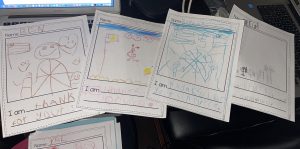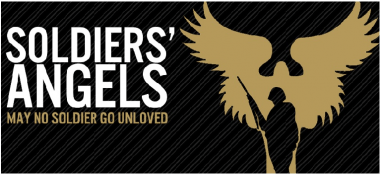Student Contributor -M. Russell
This organization, Soldier’s Angels, is something that allows everyone to support our soldiers in so many different ways. There are multiple different teams included in this organization include card and letter writing team, angel bakers team, chaplain support team, deployed adoptions team, ladies of liberty team, and special operations forces team. All of these aspects of the organization provide some kind of support and help for soldiers that might not get it from other sources. It shows the soldiers that they are loved and appreciated by a lot of people around them. For this project, I chose to register for the card writing team and send some letters from my kindergarteners to the soldiers.
After researching this organization and getting in contact with someone from the team, I finally got the chance to work with my students on what their job was. I started with a discussion of what a soldier is and all of the things that they do for our country, including how they protect us. I showed the students my example letter and helped them write out the message we decided to send which was “I am thankful for your service.” They then drew whatever picture they wanted to in the space above the words. They used lots of colors and got really creative with what they wanted to soldiers to receive. It was super cool to see the way the kids were so interested in this project and how happy they were that I was actually sending the letters. This idea is a quick and easy service for the community that can be done by anyone and everyone in the school. It is a way to show kindness to the people who protect us and it helps us give back in a way that can be forgotten sometimes. A simple letter can be so powerful for someone to receive, especially in hard times and from a young student they do not even know.
 I thought the project went really well. The kids were super engaged in writing the letters and genuinely enjoyed the process, which was really cool to see. A lot of them took their time on their drawings and really wanted it to be something the soldiers were going to like. Most of the parts of my plan worked well, and I was happy to be able to do it with the whole group of students. There were a couple kids that I had to modify things for a little bit because they struggle with their writing, so they had to trace the letters that we wrote for them. It was good though because we still got to see their handwriting over ours. Another aspect of it that I would have liked to be more prepared for was introducing the topic and explaining the “why” of it all to the kids a little better. I would tell anyone that was trying to do this same project to allow your students to write whatever they want for the letter if you are in an upper grade level. Since I did this with a kindergarten class, it was a little bit harder to do this.
I thought the project went really well. The kids were super engaged in writing the letters and genuinely enjoyed the process, which was really cool to see. A lot of them took their time on their drawings and really wanted it to be something the soldiers were going to like. Most of the parts of my plan worked well, and I was happy to be able to do it with the whole group of students. There were a couple kids that I had to modify things for a little bit because they struggle with their writing, so they had to trace the letters that we wrote for them. It was good though because we still got to see their handwriting over ours. Another aspect of it that I would have liked to be more prepared for was introducing the topic and explaining the “why” of it all to the kids a little better. I would tell anyone that was trying to do this same project to allow your students to write whatever they want for the letter if you are in an upper grade level. Since I did this with a kindergarten class, it was a little bit harder to do this.



Letters to soldiers
I completed my project with my 5th graders, there were about 25 of us in total who participated. This project is a great way to make an impact on a soldier. As stated in the original post it really truly shows that somebody cares for them and we are thankful for them. Because there is such a large grade difference between the kindergarteners who participated in this activity and my 5th graders I decided they could have frame structures if they wanted, but they would get to choose the majority of what went in their letter. I started off with a friendly letter lesson. Many of my students had not written a letter before so we went over all the components that go in a letter and what a letter looks like. Next I introduced that we would be writing letters to soldiers, who soldiers were to us, and why that would be important. I also agree that it was tricky to get some students to understand the why. Some students could not grasp the concept of why we would write letters to strangers, or thought there was no way they were going to get letters back so why does it even matter what they write. For students that can’t grasp that concept it may be helpful if you could start by seeing if they have relatives or anyone they know who is a soldier to write to first, then once they start to understand the importance of the project they can move to soldiers they don’t know. Then we brainstormed ideas about what was appropriate to put in a letter to soldiers as a class. Finally once we had enough ideas I gave the students sentence frames for more ideas of what they could include if they wanted to. I also gave them blank letters. Once students finished writing their letters many chose to draw pictures on the back, which were really fun. I was really impressed with many of my students’ letters and I could tell that many of them really truly grasped the importance of service to others, and how easily you could do it, like writing letters to soldiers. This is a great activity and community service project to take part in! There are so many ways you can incorporate something like this into your curriculum at any grade level. You could use it as a continuation or for a lesson itself in ELA or social studies very easily.
I did a similar project to this one, and I noticed that M.Russell said that their students were very engaged and enjoyed the process of writing the letters. I found this as well in my own students. They were excited to be able to do something kind for the veterans. M. Russell said that they modified the letter a bit for the students who had trouble writing, and I would say I had to do the same but I just had them type it. Many of my students struggle to write, and so almost all typed it. Which I found to be less genuine than a hand written letter, so next time I’ll consider outlining a letter for them to write. I really like how this creator had their students draw a picture for the soldiers, that makes it seem connected to the soldiers in a way. I noticed that this project can be used at all ages, because M.Russell used this in a Kindergarten classroom, and my 5th graders loved this as well. I think kids enjoy acts of service and it can be beneficial to all ages.
The civic engagement that I chose was very similar to this one. Mine differed slightly because I had my students write the children of soldiers. I decided to have my third graders write to the children of military families because often we forget that they are also sacrificing alongside their parent (s). Though the children of soldiers might not be sacrificing the same thing, they are still deployed and having a parent in war. This brought me to the idea of having children write heartfelt letters to other children to make their experience even a little bit better. My goal was to have military children feel appreciated and special. My students enjoyed this project and loved learning about what life looks like for a military family. In fact, many of them related to having parent in the military or a family member and how challenging it is. For the letter, I printed out templates for students to use with cartoon children wearing military uniforms. I guided them in writing by putting vocabulary words on the white board that they could include in their letter. After they finished writing their letter, they colored in the pictures and decorated the paper. Something that I would have changed is being more explicit on directions and making sure students know why they are writing to military children. Overall, the project went well and students were engaged and on task the entire time. It was exciting to see how much students like to spread kindness and find enjoyment in helping others.